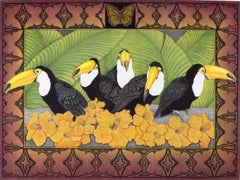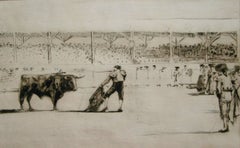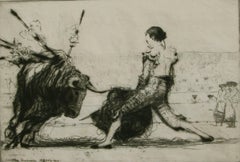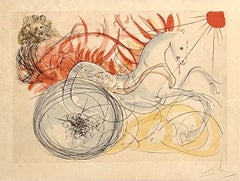Drypoint Animal Prints
Color: Brown
Medium: Drypoint
Rainforest Tapestry(colorful image of birds, ferns and flowers found in tropics)
Located in New Orleans, LA
Sharon Augusta Mitchell created this vividly colored image of five toucans with bright yellow bills set against a background of green tropical ferns and bright orange flowers. The im...
Category
Late 20th Century Contemporary Drypoint Animal Prints
Materials
Drypoint, Mezzotint, Aquatint
EVENING FLIGHT
By Roland Clark
Located in Portland, ME
Clark, Roland. EVENING FLIGHT. Derrydale 11. Etching and drypoint, 1929. Edition of 75. Signed in pencil. 12 x 15 inches. In excellent condition.
Category
1920s Drypoint Animal Prints
Materials
Etching, Drypoint
The Matador.
By James McBey
Located in Storrs, CT
The Matador. 1911. Drypoint. Hardie 109. 6 7/8 x 10 7/8 (sheet 7 7/8 x 12). Edition 15. A few scattered foxing marks and slight mat line; otherwise fine o...
Category
1910s Modern Drypoint Animal Prints
Materials
Drypoint, Etching
A Fierce Bull
By James McBey
Located in Storrs, CT
A Fierce Bull. 1911. Drypoint. Hardie 108. 5 3/8 x 8 (sheet 8 5/16 x 11 7/8). Edition 8. An exceptional impression with rich drypoint burr printed on antique laid paper. A proof of t...
Category
1910s Modern Drypoint Animal Prints
Materials
Drypoint, Etching
Related Items
"Nohubo remedio" (There was no remedy) - Etching and Aquatint on Paper
Located in Soquel, CA
"Nohubo remedio" (There was no remedy) - Etching and Aquatint on Paper
Bold 3rd or 4th edition, circa 1868-1878, with burnished aquatints, drypoints etching, and engravings by Franc...
Category
1790s Old Masters Drypoint Animal Prints
Materials
Engraving, Paper, Etching, Aquatint
H 22.5 in W 20.5 in D 1.5 in
Surrealist Salvador Dali Large Pochoir Etching Drypoint Lithograph Chariot Rider
Located in Surfside, FL
Salvador Dalí (1904-1989) – Spanish painter, graphic artist and sculptor.
Drypoint with etching and pochoir on Japon paper
"Elijah and the Chariot," 1975, (Horse and rider)
from the "Our Historical Heritage" suite.
Pencil signed along the lower right and numbered 53/250 along the lower left.
Literature: Field 75-4 J
Framed; Height: 29 in x width: 35 in. Mat opening 19.5 X 25.5.
The Spanish artist’s extensive oeuvre not only includes watercolors, drawings and sculptures but also tapestries; here a fine example from the limited edition ‘The Twelve Tribes of Israel’
The tapestry was created after an etching by Salvador Dalí from 1973 with the title ‘The Tribe of Judah’, which the artist created as part of a suite to mark the 25th anniversary of the State of Israel, and in which he represented the twelve tribes of Israel. This vintage French tapestry is an impeccable textile re-creation of a rare Dali etching. This is a flat weave Aubusson style tapisserie. The edition size was 500. The tapestry is inscribed with woven ‘Salvador Dalí’ lower right
Genre: Surrealism
Subject: people, architecture rendering
Medium: textile
Salvador Dali (Spanish, 1904-1989)
Salvador Dali is considered as the greatest original artist of the surrealist art movement and one of the greatest masters of art of the twentieth century.
Dali began to study art at the Royal Academy of Art in Madrid. He was expelled twice and never took the final examinations. His opinion was that he was more qualified than those who should have examined him.
In 1928 Dali went to Paris where he met the Spanish painters Pablo Picasso and Joan Miro. He established himself as the principal figure of a group of surrealist artists grouped around Andre Breton, who was something like the theoretical "schoolmaster" of surrealism. Years later Breton turned away from Dali accusing him of support of fascism, excessive self-presentation and financial greediness.
By 1929 Dali had found his personal style that should make him famous - the world of the unconscious that is recalled during our dreams. The surrealist theory is based on the theories of the psychologist Dr. Sigmund Freud. Recurring images of burning giraffes and melting watches became the artist's surrealist trademarks. Along with Rene Magritte his is considered the greatest of the Surrealists. His great craftsmanship allowed him to execute his paintings in a nearly photo realistic style. No wonder that the artist was a great admirer of the vintage Italian Renaissance painter Raphael. Meeting Gala was the most important event in the artist's life and decisive for his future career. She was a Russian immigrant and ten years older than Dali. When he met her, she was married to Paul Eluard. In 1933 Salvador Dali had his first one-man show in New York. One year later he visited the U.S. for the first time supported by a loan of US$500 from Pablo Picasso. To evade World War II, Dali chose the U.S.A. as his permanent residence in 1940. He had a series of spectacular exhibitions, among others a great retrospective at the Museum of Modern Art in New York. He has worked in paining, sculpture, tapestry, Daum glass and prints.
Dali became the darling of the American High Society. Celebrities like Jack Warner or Helena Rubinstein gave him commissions for portraits. His artworks became a popular trademark and besides painting he pursued other activities - jewelry and dated clothing designs for Coco Chanel or film making with Alfred Hitchcock.
In 1948 Dali and Gala returned to Europe, spending most of their time either in their residence in Ligate/Spain or in Paris/France or in New York. Dali developed a lively interest in science, religion and history. He integrated things into his art that he had picked up from popular science...
Category
1970s Surrealist Drypoint Animal Prints
Materials
Drypoint, Etching, Lithograph
The Cat - Etching and Drypoint by Giselle Halff- 1950s
Located in Roma, IT
The Cat is an Original etching and drypoint print on paper realized by an Anonymous artist in 1950 ca.
Good conditions with some foxing.
Category
1950s Modern Drypoint Animal Prints
Materials
Etching, Drypoint
No Reserve
H 6.3 in W 9.85 in D 0.32 in
Two Horses
By Kaiko Moti
Located in San Francisco, CA
This artwork "Two Horses" 1964, is an original color aquatint on paper by noted Indian artist Kaiko Moti, 1921-1989. It is hand signed and numbered 107/120 in pencil by the artist. ...
Category
Mid-20th Century Impressionist Drypoint Animal Prints
Materials
Aquatint
Tigre couché à l'entrée de son antre (Tiger Lying at the Entrance to its Lair)
Located in Middletown, NY
Etching, drypoint, and roulette on watermarked Hallines cream laid paper, 3 3/4 x 5 7/8 inches (95 x 148 mm), full margins. A very good impression of this charming image, with all of...
Category
Early 19th Century Realist Drypoint Animal Prints
Materials
Drypoint, Etching, Laid Paper
Her Majesty's Stag Hounds on Ascot, A Colored 19th Century British Hunting Scene
Located in Alamo, CA
"The Meeting of Her Majesty's Stag Hounds on Ascot Heath" is a large colorful mezzotint engraving of an extensive British hunting scene. It was created by Sir Francis Grant...
Category
1830s Drypoint Animal Prints
Materials
Mezzotint, Engraving
Francis Grant Her Majesty's Stag Hounds on Ascot, A Colored 19th Century British Hunting Scene, 1839
H 29 in W 38.88 in D 1.25 in
Minne Playing with a Cat (Minne Jouant avec un Chat)
Located in New York, NY
Jacques Villon (1875-1963) etching, aquatint, and drypoint, Minne Playing with a Cat (Minne Jouant avec un Chat),1907, signed in pencil and numbered (12/30)(Ginestet and Pouillon 192...
Category
Early 1900s Impressionist Drypoint Animal Prints
Materials
Drypoint, Etching, Aquatint
"Tumba y Raja", 2019, signed limited edition original art print engraving
By Jose Bedia
Located in Miami, FL
Jose Bedia (Cuban, 1959)
'Tumba y Raja', 2019
Sugarlift on iron plate
Limited edition of 30
Image size: 89.5 x 151.5 cm. (35.2 x 59.6 in.)
Overall size: 109 x 172 cm. (42.9 x 67.7 in...
Category
2010s Contemporary Drypoint Animal Prints
Materials
Metal, Iron
Returning to the Stable.
Located in Storrs, CT
Returning to the Stable. 1920. Drypoint. Appleby 64. 8 3/4 x 12 1/4 (sheet 11 7/16 x 16 1/8). Edition 100. A rich impression printed on cream laid paper wi...
Category
1920s Modern Drypoint Animal Prints
Materials
Drypoint, Etching
Spanish Artist hand signed limited edition original art print drypoint n16
Located in Miami, FL
Salvador Dali (Spain, 1904-1989)
'Jinete apocalíptico', 1974
dry point, etching on paper
22.3 x 30.4 in. (56.5 x 77 cm.)
Edition of 175
Unframed
ID: DAL2001-016
Hand-signed by author
______________________________________________________
Salvador Felipe Jacinto Dalí i Domènech was a Spanish painter, sculptor, engraver, set designer and writer of the 20th century. An artist associated with surrealism, he is one of the most important figures in 20th century art, representing the archetype of the spectacular contemporary multifaceted artist.
He develops his creative activity in various fields through the most diverse cultural formulas: painting, written media, performing arts, cinema, or public appearances in the press, radio, cinema, advertising, television, etc.
Master of the most refined pictorial technique, especially drawing, along with various aesthetic languages - from impressionism, cubism, purism or late ultraism with Dadaist edges to the most radical surrealism, hyperrealism, pop-art or art optical—, will absorb every influence that is useful to build its own and personal language, halfway between technical tradition and thematic avant-garde.
His paranoid-critical method is his main contribution to the surrealist movement and to the history of art as a new creative model with which Dalí's theories acquire theoretical entity - thanks to the successive interpretations that the Empordà artist made of his readings of Dalí's work. Sigmund Freud—and practice, applying it as a revealing liquid of images that can be represented plastically through multiple images, anamorphisms, relational mirages, irrational and heterogeneous symbolic images, pseudohallucinations, childhood memories, atavisms, obsessive ideas, etc., and recreating a polyphonic method capable of critically relating any visual or sensitive experience. With his method, Dalí makes paranoid delirium a whole mode of expression of an art that introduces us to the concrete irrationality that inhabits every creative process, constructing not only his works, but also his own character. as an artist.
In Dalí, the relationship between his work and his personal history becomes evident. Much of the most significant biographical facts for the artist are implicitly or explicitly present in the content of his work and are the explanation of his complex and contradictory personality.
In 1910, at the age of 6, he was enrolled by his father in the Hispano-French school of the Immaculate Conception of Figueres, where he learned French, his future language of culture.
Dalí's first contact with Impressionism occurred in 1916, when he spent some time on the outskirts of Figueres, specifically at the Molí de la Torre estate, property of the Pichot family (intellectuals and artists), where he was the collection of the painter Ramón Pichot.
In 1919 he participated for the first time in a group exhibition in the halls of the Societat de Concerts, and with a group of friends from the institute founded the magazine Studium, in which he published his first writings. A year later he moved to Madrid to study at the School of Fine Arts.
In 1922 he won his first prize at the Concurs-exposició d'obres d'art originals d'students, held at the Galeries Dalmau (Barcelona). This same year he attended the School of Painting, Sculpture and Engraving in Madrid (Royal Academy of Fine Arts of San Fernando), and lived in the Student Residence, where he became friends with prominent personalities such as Luis Buñuel, Federico García Lorca, Pedro Garfias , Eugenio Montes, or Pepín Bello.
However, a year later he was expelled from the Academy for his rebellious and revolutionary character, accused of leading a protest. It would be in 1927 when his surrealist period began, after having traveled to the Netherlands and France, meeting Flemish painters and Picasso. In Paris itself, in 1929, through Joan Miró, he came into contact with a group of surrealists headed...
Category
1970s Surrealist Drypoint Animal Prints
Materials
Paper, Drypoint, Etching
Salvador Dali, Le Cerf Malade Signed Etching Engraving, Color Lithograph Pochoir
Located in Surfside, FL
An original signed drypoint etching with color pochoir by Spanish artist Salvador Dali titled "La Cerf Malade", depicting a stag deer, from the Portfolio: Le Bestiaire de la Fontaine. Hand signed in pencil and hand numbered. Limited edition in Roman numerals.
Image size: 22.5" x 15.5". Sheet size is about 31 X 23 inches
Le Bestiaire de la Fontaine Dalinisé, Robert Mouret, Editiones des Maîtres Contemporains, Paris, 1974 (M. & L. 653-664) (Reference: Albert Field, page 93 image 74-1F.)
signed and numbered intaglio drypoints with pochoir in colors, hors-texte, on Arches, there were also editions of 250 on Japon and 120 on Auvergne numbered in Roman numerals.
Salvador Dali (Spanish, 1904-1989 )is considered as the greatest original artist of the surrealist art movement and one of the greatest masters of art of the twentieth century.
Dali began to study art at the Royal Academy of Art in Madrid. He was expelled twice and never took the final examinations. His opinion was that he was more qualified than those who should have examined him.
Surreal Art
In 1928 Dali went to Paris where he met the Spanish painters Pablo Picasso and Joan Miro. He established himself as the principal figure of a group of surrealist artists grouped around Andre Breton, who was something like the theoretical "schoolmaster" of surrealism. Years later Breton turned away from Dali accusing him of support of fascism, excessive self-presentation and financial greediness.
By 1929 Dali had found his personal style that should make him famous - the world of the unconscious that is recalled during our dreams. The surrealist theory is based on the theories of the psychologist Dr. Sigmund Freud. Recurring images of burning giraffes and melting watches...
Category
1970s Surrealist Drypoint Animal Prints
Materials
Color, Drypoint, Etching
The Cornfield
Located in Storrs, CT
Mezzotint by David Lucas (1802 - 1881) after the painting by John Constable. Shirley catalog 3 state 6.iv. Christopher Lennox-Boyd state vi/vi. London: Republished Feb.y 15, 1853, by Thomas Boys (of the late Firm of Moon, Boyd & Greaves,) Printseller to the Royal Family, 467, Oxford Street - Paris. E.Gambart & C. 9 Rue d'Orleans au Marais,-Depose. Originally Published July 1.1834. Image 22 1/4 x 19 1/2, plate 26 3/4 x 20 3/8, sheet 30 3/4 x 24 3/8. A rich impression printed on sturdy wove paper with full margins, mounted on archival paper. A few unobtrusive scrapes and folds, one horizontally across the center of the image, and a faint water stain in the top right-hand image and margin. Signed in the plate.
Housed in a double archival mat and a Hogarth 36.50 x 30.50 x 1.25-inch Hogarth frame with gilded corner ornaments.
-------------------------------------------------------------------------------------------------
The Cornfield depicts Fen lane as it leads from East Bergholt towards Dedham; a village in the borough of Colchester. A flock of sheep are followed by a dog as the path winds towards figures active in a cornfield. A boy, prone and with his face on the surface of a stream, slakes his thirst. The church in the distance is thought to have been an invention on Constable's part.
---------------------------------------------------------------------------------------------------------
First exhibited at the Royal Academy in 1826, Constable's The Cornfield became one of the artist's most celebrated works. It was reproduced in mezzotint by David Lucas in 1834 and sold by J. McLean and Hodgson, Boys and Graves, and Rudolph Ackermann. This print, however, derives from a posthumous collection of Constable's works entitled 'English Landscape Scenery,' edited by H.G. Bohn and published by Thomas Boys in 1853. The series consisted of forty mezzotint engravings on steel plates; all of which were produced by Lucas.
----------------------------------------------------------------------------------------------------
The Cornfield is one of Constable’s best-known works. It was also the first of his pictures to enter a public collection. Shortly after his death in 1837, a committee was set up to subscribe towards the purchase of a painting for the nation, and The Cornfield was bought for the National Gallery for 300 guineas. The list of subscribers included the poet William Wordsworth, the scientist Michael Faraday...
Category
19th Century Romantic Drypoint Animal Prints
Materials
Mezzotint
Drypoint animal prints for sale on 1stDibs.
Find a wide variety of authentic Drypoint animal prints available on 1stDibs. While artists have worked in this medium across a range of time periods, art made with this material during the 21st Century is especially popular. If you’re looking to add animal prints created with this material to introduce a provocative pop of color and texture to an otherwise neutral space in your home, the works available on 1stDibs include elements of yellow and other colors. There are many well-known artists whose body of work includes ceramic sculptures. Popular artists on 1stDibs associated with pieces like this include Salvador Dalí, Pablo Picasso, Edmund Blampied, and James McBey.. Frequently made by artists working in the Modern, Surrealist, all of these pieces for sale are unique and many will draw the attention of guests in your home. Not every interior allows for large Drypoint animal prints, so small editions measuring 0.5 inches across are also available





